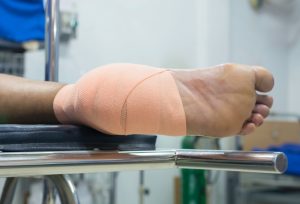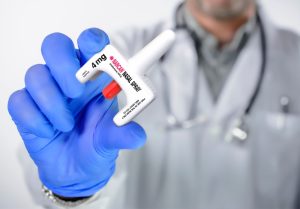December 2023
Inside This Issue
Happy Holidays to all our readers! Thanksgiving is over, except perhaps for some leftovers lost in the back of the refrigerator, and there are likely many more festivities and family gatherings to participate in between now and January 2nd. There are also many patients who are still in need of your services this month, but in January there will feel a sense of newness and anticipation for the coming year and wonder about what regulators and accreditors will send your way.
 Sentinel Event Involving Suicide:
Sentinel Event Involving Suicide:
This month’s Perspectives discusses changes that TJC has made to their definition of a sentinel event involving suicide. We noted that TJC assigned an effective date to this change of January 1, 2024. TJC usually provides at least 6 months’ notice of changes to requirements, consistent with the accreditation contract between your organization and Joint Commission, but we have to assume TJC considers this a patient safety issue requiring a more expedited timeline.
It is also possible that TJC would consider this a policy issue, not a standards issue, however it becomes a standards issue in LD.03.04.09, EP 4, which requires your sentinel event policy to be consistent with their policy. Currently they define a suicide sentinel event as a suicide occurring in a 24-hour staffed setting or within 72 hours of discharge from that setting, or within 72 hours of discharge from the emergency department.
The new definition expands that discharge responsibility to within 7 days of discharge from a 24-hour setting or the ED. In addition, the new definition now specifically includes while in, and within 7 days of discharge from day treatment, partial hospitalization, intensive outpatient, residential, group home, and transitional supportive living. As 2024 is just around the corner, readers, and in particular those due for a survey in the first quarter of 2024, will want to revise their own sentinel event policies and definitions to remain consistent with the changed requirements.
We took a quick look at the E-dition for January and noted that the SE chapter does already include these new requirements. As you begin your policy analysis and revisions you may want to review all the definitions to ensure your policy changes have captured other changes TJC has made the past few years.
Searching our own newsletter, we identified multiple terminology and definition changes including:
- Nov 2019: invasive procedure, hemolytic transfusion reaction, and fire definitions
- June 2020: falls definition
- Dec 2020: rape, assault, homicide categorization
- Oct 2022: sexual assault/abuse definition
The reporting of sentinel events remains voluntary; however, you can’t be compliant with the requirements if you define sentinel events differently than TJC does. So do take a look at your policy to make edits so that it is consistent with the current definitions described in the SE chapter. While your definition can be more expansive than Joint Commission, it cannot be more limited than TJC.
 Summary of Changes- Revisions and Removals:
Summary of Changes- Revisions and Removals:
While we are discussing changes, the December issue of Perspectives has an annual summary of publication dates for new content and a brief discussion of what has changed in the manuals. The first page of the article has a grid with publication schedules for each accreditation program in the E-dition, the second 2023 update, the 2024 comprehensive manuals, the abridged minibooks, and their PDF versions. With the exception of stroke and orthopedic certification, the E-dition appears to be the most up to date reference, so we would suggest using that source during your verification or readiness analysis.
The narrative summary of changes discusses all accreditation programs, so if you manage multiple tailored programs, you have one-stop shopping. If you have only one accreditation program, you will just want to read carefully to separate out only the changes applicable to your organization. This summary does provide a nice reminder of what is changing and an opportunity to verify readiness. You can also apply a filter in the E-dition of your manual to identify only those standards which are new for 2024, which will provide you a tool to focus your verification of readiness.
 Critical Areas and Ventilation Systems:
Critical Areas and Ventilation Systems:
This month’s Consistent Interpretation column discusses EC.02.05.01, EP 15 which is a very heavy hitter with 36% of hospitals being scored noncompliant. The EP requires critical areas designed to control airborne contaminants including biologic agents, gases, fumes, and dust to maintain the appropriate air pressure relationship, air exchange rates, filtration efficiency, temperature, and humidity. In theory this sounds easy, and if you design and construct an area to fulfill these requirements, the room should work as designed, but there is a lot that can go wrong over time.
The most common issues we see on consults and in accreditation reports are temperature, humidity, and air pressure problems. Temperature and humidity problems are often human caused, where for personal comfort someone has substantially lowered the thermostat, and due to the inverse relationship between temperature and relative humidity, the humidity reading goes too high, exceeding the maximum allowable humidity of 60%.
The temperature may be lowered below the ASHRAE allowable limit of 68 degrees for documented reasons on a specific case but must return to allowable limits after the case is concluded. Temperature and humidity problems can sometimes be due to extreme weather, such as winter weather, when the continual use of heat takes the natural humidity below 30%. Just about everyone remembers that CMS permitted healthcare organizations to allow humidity levels between 20-30%, but too few remember that this needed to be done after a formal, documented risk assessment was completed that verified the equipment and supplies in the area could operate safely at this lower range.
The third very frequent problem is air pressure not being consistent with the design requirements. For example, an operating room, sterile, nonhazardous compounding area, or central sterile processing area, which should all be under positive pressure, and on the day of survey they find it not to be positive. Similarly, hazardous compounding and central processing decontamination should be under negative pressure.
These pressures can go out of alignment for many reasons including, a fan break, a loose fan belt, leaving a door open in the critical space, or by creating a wind tunnel by leaving exterior doors open in adjacent spaces. The key to managing this issue is to give staff a tool such as a sensor and alarm to verify pressure is within limits and to use the tool effectively. Sometimes staff shut off the alarm because it is ringing, but they don’t get the cause for the alarm corrected in a timely fashion and continue to use the space.
Do take a look at the surveyor observations of noncompliance discussed in this months’ column. They identify many similar and diverse reasons why this is such a difficult standard to maintain in compliance.
 Quick Safety on Pressure Injuries:
Quick Safety on Pressure Injuries:
In October, Joint Commission published Quick Safety #70 on Early Identification and Evaluation of Severe Pressure Injuries. A link to the Quick Safety is provided in the Perspectives article. In this brief article TJC discusses risk factors, warning signs and symptoms, and provides four safety actions to consider. While the content does not necessarily sound like anything we have never heard hospital staff discuss, there may be one or more content points that are not as well known in your organization, so do take a look.
There are many springboards for discussion of pressure injuries during a survey, from individual patient tracers to PI/data discussions, unit-based PI projects or other. We would suggest sharing the Quick Safety with those who may be involved in leading your organizations efforts at preventing pressure injuries and the staff to determine if there is content you want to incorporate.
In addition, it is always a good idea for staff to be able to be able to discuss TJC safety initiatives if asked by a surveyor, allowing staff to speak to how the recommendations are utilized.
 Simplification of MS.06.01.05, EP 6:
Simplification of MS.06.01.05, EP 6:
The December Perspectives also discusses the removal of a note that is currently a part of MS.06.01.05, EP 6. The EP has always been clear and simple; however, the current note adds complexity, ambiguity, and workload because it seems to expand the requirement substantially beyond what the EP says.
Well, the good news is TJC now agrees, and they are deleting the entire note. The EP requires: “An applicant submits a statement that no health problems exist that could affect their ability to perform the privileges requested.” If you have been exceeding that simple requirement and want to dial the workload back a notch, you can now that the ambiguity of the note has been removed.
 Opioid Reversal Agents:
Opioid Reversal Agents:
There was one new FAQ posted during the past month that drew our attention because it deals with a very current issue and that is the availability of opioid reversal agents that might be stocked in nonpatient care areas. While the medical staff FAQ discussed above represents a simplification, this one appears to us to have been put through the TJC complexification machine.
The introduction to the FAQ states that TJC will evaluate compliance based on your states program, however if your state has not created an opioid reversal agent availability program, TJC advises considering these issues relative to making reversal agents available in nonpatient care areas.
- Evaluate Medication Security: All medications must be stored in a manner to prevent tampering, theft, or diversion, and of course, consistent with your policies. Internal access policies may need refinement. TJC suggests a risk assessment as a helpful method to evaluate access, standards compliance and compliance with law and regulation.
- Evaluate Storage: Medications must be stored consistent with the manufacturer’s guidance for temperature and light as detailed in the package insert. The package insert guidance cannot be “superseded” by the organizations risk assessment.
- Evaluate Orders: An order is required to administer any medication in the hospital setting. In emergent situations the organization may consider the use of standing orders per MM.04.01.01, EP 15 that are approved by the medical staff, nursing, and pharmacy leadership. We know that many states have approved standing orders to do just this. The FAQ then continues to require that the protocol include pre-established and approved patient assessment criteria and to define in writing who is authorized to administer medications in accordance with law and regulation.
- Documentation: TJC states in the FAQ that once the organization chooses to treat an individual, they become a patient of the organization, therefore a medical record should be developed.
- Education and Training: The organization determines the education, training, or competency requirements for those involved in responding to patient emergencies.
- Evaluate MM Practices: Standard MM.08.01.01 requires the organization to evaluate the effectiveness of their MM systems. Therefore, organizations are encouraged to evaluate safe medication use during emergencies for PI opportunities.
This FAQ came out just before Thanksgiving so it may have missed your attention. Given that Narcan nasal spray is now available OTC and the many public health entities are trying to facilitate access, we anticipate that this may continue to undergo additional refinement and hopefully simplification. The Federal Substance Abuse and Mental Health Services Administration also has an FAQ on naloxone OTC where they anticipate that naloxone OTC will soon be available in convenience stores, grocery stores, gas stations, and online. Some states are making it available free of charge and in Michigan they are even creating vending machines to make naloxone available without cost to the consumer.
 New Sterile Compounding Evaluation Tool:
New Sterile Compounding Evaluation Tool:
TJC has posted their new sterile compounding evaluation tool to their extranet site. We found it on the “Resources and Tools” page, under the header “Learn More.” The tool looks similar to the old tool; however, it now has key content requirements from the new USP Chapters 797 and 800 as well as guidance to surveyors to score everything under the recently revised elements of performance for MM.05.01.07.
The tool starts with key indicators for evaluating the primary (hood) and secondary (room) engineering controls, much of which will come from your certification reports shared with surveyors in your day one documents. Then they have key indicators for evaluating the cleanability of the physical environment, processes of hand hygiene, and garbing. They then go into more specific detail about the process of actually performing sterile compounding, followed by decontamination and or disinfection of the compounding spaces. TJC then listed key competency requirement details and frequencies. They conclude with a nice, one page table of maximal beyond use dates for products prepared.
Now that we know what surveyors will be focused on, the question is how to best utilize this tool to help us prepare. We would suggest a two-person interview/audit/document review with a pharmacy or hospital manager/administrator and the “designated person(s)” going through each criterion TJC advises its surveyors to evaluate. The interviewer/administrator should forget what they already may know about processes in place and evaluate solely on what the designated person says, and supportive documentation they provide during the interview.
You likely will find that documentation of competencies, policies, certification reports and other supportive documentation is stored on paper all over the organization, or stored in databases maintained by multiple people, in multiple locations and thus getting it organized prior to the actual survey will be a big help. By conducting a formal audit, you may also notice some physical defects in the compounding space that need repair to be “easily cleanable” or staff lapses in techniques.
 Emergency Management Leader Publication:
Emergency Management Leader Publication:
The lead article in EC News mentions that they will be moving emergency management content out of EC News and into a new publication called Emergency Management Leader. This is somewhat of a good news/bad news announcement. There may be additional content and guidance, but there will also be a new subscription requirement if you choose to obtain the new publication.
At present EM standards are not scored at the same frequency as EC and LS, but if surveyors start to see greater depth of detail about EM topics, perhaps scoring frequency in the EM chapter will increase. This will be a bimonthly publication, starting in February and the first issue will be shipped free to EC News subscribers, so you will get an opportunity to decide if you wish to purchase a subscription.
 Behavioral Health Workplace Violence Standards:
Behavioral Health Workplace Violence Standards:
This month’s edition of EC News has an article developed for the behavioral health industry on workplace violence. TJC has been developing new workplace violence standards for behavioral health and the article mentions that they intend to publish draft standards to their prepublication page of the website by January. Organizations with accredited behavioral health programs will want to be on the lookout for this draft and comment as appropriate.
The behavioral health standards will be unique to behavioral health but will draw from what currently is already published in the hospital manual. The article identifies the existing hospital elements of performance and provides insight into what is being scored, the frequency of scoring and the placement on the SAFER® Matrix. While the article may provide a look into the future for behavioral health organizations it also provides useful information to hospital readers on scoring patterns or problematic standards relative to workplace violence.
Sharps Containers Requirements:
The last article in EC News is a Q+A format discussion about requirements for sharps containers. Over the years we have seen a great diversity of findings relative to sharps containers: mounted too high, too low, tippy, not secured, etc. and this article and the reference to an updated FAQ on this same issue helps to sort fact from fiction. There is also an FAQ is in the EC chapter, specifically EC.02.01.01, and it was most recently updated Oct 24, 2023.
Both the FAQ and the EC News article provide guidance on height requirements from NIOSH, which are 52-56 inches high for a standing workstation and 38-42 inches high for a seated workstation. The FAQ provides links to additional information from OSHA and the CDC.
 Rural Emergency Hospitals:
Rural Emergency Hospitals:
CMS published one new QSO this month that may be of interest to our readers and that was QSO 24-01 dated 11/3/23. This was targeted to hospitals that might be looking to convert to the new provider category called rural emergency hospitals.
The QSO discusses the certification process and hospitals currently participating in Medicare will not have to undergo a conversion survey as they are currently considered to be in compliance with Medicare requirements. Hospitals that had lapsed their participation in Medicare will have to undergo a conversion survey and only state agency surveyors may perform these surveys for the first three years. Deemed status arrangements may be considered in the future, but not during the first 3 years of the new program.
Consultant Corner
Dear Readers,
Adverse Events, Immediate Jeopardy, Immediate Threat to Health and Safety, Preliminary Denial of Accreditation, Condition Level Deficiency are all worrying terms to have happen at your organization. Unfortunately they occur frequently and according to the NIH, at least one in ten patients, or over 250,000 patients, are affected by an adverse event every year.
Any adverse outcome has the potential to impact your clinical operations and accreditation status. Time is not on your side and receiving one requires an immediate or rapid response.
That is why we are your essential next step. We enable you to deliver a timely and effective response, minimizing disruptions, and ensure you retain accreditation status – we proudly have a 100% success rate for all PDA clients. Contact us if this happens to you, we can help!
SEASONS GREETINGS

This Holiday Season, we turn gratefully to all who have strived to make healthcare a better place.
We wish you a Joyous Holiday Season and a Happy New Year!
Thank You,
Jennifer Cowel, RN MHSA
JenCowel@PattonHC.com
Julia Finken, RN, BSN, MBA, CPHQ
julia.finken@hbsinc.com
Kurt Patton, MS RPh
Kurt@PattonHC.com
John Rosing, MHA
JohnRosing@PattonHC.com
